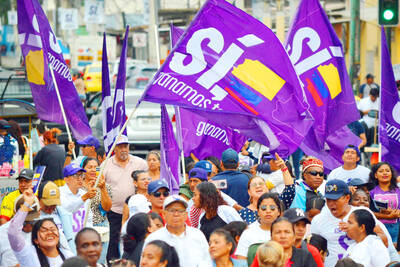The US announced on Friday that all of the US troops based in Seoul would be moved out of the South Korean capital by December 2008.
The Pentagon, in a statement, said US and South Korean officials had finalized an agreement here this week to redeploy the approximately 8,000 US troops in Seoul to new military facilities in Pyongtaek, some 80km south of the capital.
"The relocation of US forces out of Seoul will be completed by December 2008," the US Defense Department statement said.
It said that US and South Korean officials, at their 10th round of talks, had also finalized amendments to the plan to eventually relocate the 2nd Infantry Division from camps north of Seoul to facilities in the Pyongtaek area.
The 14,000-strong 2nd Infantry Division is based along the Demilitarized Zone with North Korea.
"A final decision on the timing of the 2nd Infantry Division relocation will be decided by the respective national leaders at a later date," the statement said.
The decision would be made "taking careful account of the political, economic and security situation on the peninsula and in Northeast Asia," it added.
US forces have been based at Yongsan in Seoul since the 1945 defeat of Imperial Japan in World War II. The sprawling installation occupies 252 hectares in the heart of the South Korean capital of 11 million people.
The base, which grew dramatically in size after the 1950-1953 Korean War, has been a major symbol of the US military presence in intensely nationalistic South Korea and the target of numerous anti-American protests.
The two sides had been aiming for an agreement that would relocate the US military base out of Seoul by 2007. Negotiations have been bogged down in discussions over the costs of relocation and the amount of land to make up the new US military facilities.
Richard Lawless, the US Deputy Under Secretary of Defense for Asia Pacific affairs and top US negotiator, welcomed the agreement announced on Friday.
"This relocation agreement helps us meet our enduring commitment to the defense of Korea and to the security and stability of the region," he said.
Lawless and Evans Revere of the State Department led the US delegations to the talks while South Korea was represented by Ahn Kwang Chan of the Ministry of National Defense, and Kim Sook from the Ministry of Foreign Affairs and Trade.
The US has already announced plans to withdraw some 12,500 troops from its 37,000-strong military contingent in South Korea as part of a global review designed to produce a more agile fighting force. It has insisted any withdrawal would not weaken its deterrent against North Korea.
Despite an unresolved showdown with Pyongyang over its nuclear weapons program, Pentagon officials maintain that the nearly 700,000-strong South Korean military can plug any troop gap.
US ground troops have served as a guarantee since the end of the Korean War that any invasion of the South would immediately draw in the US. But more than half a century later, Pentagon officials contend the so-called "tripwire" is an anachronism in an age of high tech sensors and computer networks, precision weapons and US military dominance in the air and at sea.

A feud has broken out between the top leaders of the far-right Alternative for Germany (AfD) party on whether to maintain close ties with Russia. The AfD leader Alice Weidel this week slammed planned visits to Russia by some party lawmakers, while coleader Tino Chrupalla voiced a defense of Russian President Vladimir Putin. The unusual split comes at a time when mainstream politicians have accused the anti-immigration AfD of acting as stooges for the Kremlin and even spying for Russia. The row has also erupted in a year in which the AfD is flying high, often polling above the record 20 percent it

Ecuadorans are today to vote on whether to allow the return of foreign military bases and the drafting of a new constitution that could give the country’s president more power. Voters are to decide on the presence of foreign military bases, which have been banned on Ecuadoran soil since 2008. A “yes” vote would likely bring the return of the US military to the Manta air base on the Pacific coast — once a hub for US anti-drug operations. Other questions concern ending public funding for political parties, reducing the number of lawmakers and creating an elected body that would

The latest batch from convicted sex offender Jeffrey Epstein’s e-mails illustrates the extraordinary scope of his contacts with powerful people, ranging from a top Trump adviser to Britain’s ex-prince Andrew. The US House of Representatives is expected to vote this week on trying to force release of evidence gathered on Epstein by law enforcement over the years — including the identities of the men suspected of participating in his alleged sex trafficking ring. However, a slew of e-mails released this week have already opened new windows to the extent of Epstein’s network. These include multiple references to US President Donald

CHARGES: The former president, who maintains his innocence, was sentenced to 27 years and three months in prison for a failed coup bid, as well as an assassination plot Far-right former Brazilian president Jair Bolsonaro is running out of options to avoid prison, after judges on Friday rejected his appeal against a 27-year sentence for a botched coup bid. Bolsonaro lost the 2022 elections and was convicted in September for his efforts to prevent Brazlian President Luiz Inacio Lula da Silva from taking power after the polls. Prosecutors said the scheme — which included plans to assassinate Lula and a top Brazilian Supreme Court judge — failed only due to a lack of support from military top brass. A panel of Supreme Court judges weighing Bolsonaro’s appeal all voted to uphold